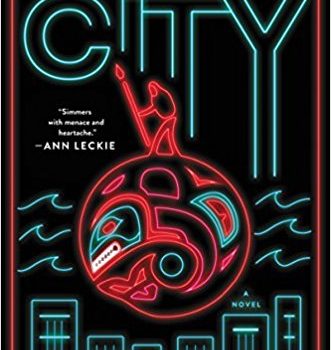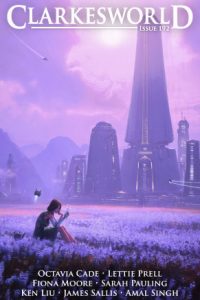Gary K. Wolfe Reviews Blackfish City by Sam J. Miller
 Blackfish City, Sam J. Miller (Ecco 978-0-06-268482-0, $22.99, 336pp, hc) April 2018.
Blackfish City, Sam J. Miller (Ecco 978-0-06-268482-0, $22.99, 336pp, hc) April 2018.
If Sam J. Miller’s debut novel The Art of Starving was an intimate portrait of a troubled but appealing teen grappling with personal demons like bullies and eating disorders, his SF debut Blackfish City is expansive, ambitious, violent, rich in invention, and populated by a range of colorful figures whose characteristics sometimes seem drawn from sources as diverse as The Godfather, classic urban noir, a few familiar SF tropes, Samurai movies, and even superhero comics (at least there’s some Spiderman-style building-scrambling). Not least among these characters is the setting itself – the remarkable eight-armed artificial ocean city of Qaanaaq (which we first glimpsed in Miller’s celebrated 2015 story “Calved”), “east of Greenland, north of Iceland” and home to a population of almost a million, many of whom are refugees from the drowned or abandoned cities of the “Sunken World.” (By now we’re so inured to inundations and dislocations caused by climate change that a simple phrase is about all we need by way of backstory, though Miller does offer a few more details, mentioning that the most recent effort at an American government has collapsed.) It’s about as different in scope and tone from The Art of Starving as it can get, but it’s also the first SF debut novel I’ve seen this year that promises to have as striking an impact as Annalee Newitz had last year with Autonomous (which, interestingly enough, also partly took place in a growing Arctic city, Iqaluit). But instead of robots, Miller offers us killer whales and polar bears, and instead of bonding with your robot, something called “nanobonding,” by which humans can share awareness with particular animals because of nanomites in the bloodstream.
Qaanaaq is interesting for a number of reasons. It’s fueled by undersea thermal vents and governed mostly by artificial intelligences, and although there is a managerial class, capitalism seems virtually unregulated, while a criminal syndicate has amassed its own power. The wealthy live in plush accommodations with moving gardens and twenty-story buildings, while the refugees and itinerant workers of the “upper arms” barely subsist in what amount to stacks of shipping crates. The main viewpoints are those of Ankit, chief of staff to an ambitious politician; Fill, a wealthy heir to one of the city’s shareholders, suffering from an unusual condition called the breaks (which, unleashed by “big pharma,” has odd effects on memory, later explained in an ingenious but credible way); Kaev, a skilled but damaged professional fighter who makes his living deliberately throwing fights to accommodate the corrupt sport (“beam fighting,” a kind of logrolling fought on beams above the ocean); and Soq, a nonbinary street urchin working mostly as a messenger for the mob, which is led by a ruthless godmother named Go.
It takes a while for Miller to reveal how these characters and their worlds are intertwined, since at first each seems to have a different agenda. Ankit, for example, wants to free her mother from a psychiatric facility-cum-prison called the Cabinet, while Kaev – who turns out to be her brother – is simply looking for an honorable way to retire and survive. Fill is interested in discovering the author of an anonymous broadcast called City Without a Map, a kind of insider’s guide to Qaanaaq which Miller also uses, sometimes a bit blatantly, as an ongoing infodump, a bit like Dos Passos’s “camera” segments of his U.S.A. trilogy. What does eventually knit the characters together is a figure who makes a spectacular appearance in the novel’s opening scene: a mysterious woman riding a skiff towed by a killer whale, and accompanied by a huge polar bear. She seems a bit intimidated by the bear, but it becomes apparent that she and the orca are nanobonded – which many view as a kind of unholy abomination. After she goes all Kill Bill on a mob trying to attack her, we learn what her real motive is, and how she is connected to the other characters. Miller’s conclusion may seem a bit rushed and CGI-ready, after a novel so dense with ideas and fully-realized characters, but at the same time it makes clear that, beyond the technology and pyrotechnics, Blackfish City is, rather surprisingly, also a novel about family, responsibility, and the possibility of community.
Gary K. Wolfe is Emeritus Professor of Humanities at Roosevelt University and a reviewer for Locus magazine since 1991. His reviews have been collected in Soundings (BSFA Award 2006; Hugo nominee), Bearings (Hugo nominee 2011), and Sightings (2011), and his Evaporating Genres: Essays on Fantastic Literature (Wesleyan) received the Locus Award in 2012. Earlier books include The Known and the Unknown: The Iconography of Science Fiction (Eaton Award, 1981), Harlan Ellison: The Edge of Forever (with Ellen Weil, 2002), and David Lindsay (1982). For the Library of America, he edited American Science Fiction: Nine Classic Novels of the 1950s in 2012, with a similar set for the 1960s forthcoming. He has received the Pilgrim Award from the Science Fiction Research Association, the Distinguished Scholarship Award from the International Association for the Fantastic in the Arts, and a Special World Fantasy Award for criticism. His 24-lecture series How Great Science Fiction Works appeared from The Great Courses in 2016. He has received six Hugo nominations, two for his reviews collections and four for The Coode Street Podcast, which he has co-hosted with Jonathan Strahan for more than 300 episodes. He lives in Chicago.
This review and more like it in the April 2018 issue of Locus.

While you are here, please take a moment to support Locus with a one-time or recurring donation. We rely on reader donations to keep the magazine and site going, and would like to keep the site paywall free, but WE NEED YOUR FINANCIAL SUPPORT to continue quality coverage of the science fiction and fantasy field.








